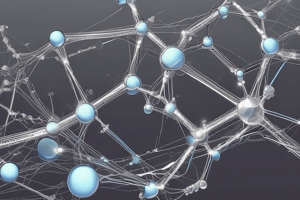Podcast
Questions and Answers
What is a common characteristic we often associate with living organisms?
What is a common characteristic we often associate with living organisms?
- Visible movement (correct)
- Presence of color
- Ability to reproduce
- Need for sunlight
Why is molecular movement considered essential for life?
Why is molecular movement considered essential for life?
- It prevents aging.
- It facilitates growth and repair. (correct)
- It is the only sign of life.
- It contributes to color variation.
Which of the following statements is true regarding plants?
Which of the following statements is true regarding plants?
- Plants require visible movement to be classified as living.
- Plants grow over time even if not visibly moving. (correct)
- Plants can only be identified by their green leaves.
- Plants are not considered alive when they stop growing.
What role does the ordered nature of living structures play in defining life?
What role does the ordered nature of living structures play in defining life?
What is a key debate regarding viruses in the context of life?
What is a key debate regarding viruses in the context of life?
How can we tell the difference between living and non-living entities when movement is not present?
How can we tell the difference between living and non-living entities when movement is not present?
What happens to the organized structures of living organisms over time without maintenance?
What happens to the organized structures of living organisms over time without maintenance?
Which of the following is NOT a maintenance process for living organisms?
Which of the following is NOT a maintenance process for living organisms?
Study Notes
Differentiating the Living from the Non-Living
- Living beings exhibit observable activities, such as movement, breathing, or vocalization.
- Even when asleep, organisms like dogs, cows, or humans can be identified as alive based on their potential to breathe.
- Green plants are often perceived as alive; however, color does not always indicate life.
Characteristics of Life
- Growth is a common criterion for determining life; yet, organisms can be alive without visible growth.
- Some life forms, such as dormant plants or certain animals, may not display evident movement but are still alive.
- Molecular movement, although invisible to the naked eye, plays a crucial role in sustaining life.
Molecular Movement and Life
- Biologists affirm that molecular movement is essential for life processes.
- Viruses lack internal molecular movement until they invade a host cell, contributing to the debate over their classification as living entities.
Importance of Molecular Movements
- Living organisms are structurally organized into tissues, cells, and smaller components.
- Environmental factors can lead to the decay of this organizational structure; if it deteriorates, the organism will die.
- Maintenance of order within living systems requires constant molecular movement to repair and support their structures.
Maintenance Processes in Living Organisms
- Organisms actively manage their internal environment to maintain their organized state, essential for survival and functionality.
- Understanding these processes offers insight into what constitutes life and the necessary conditions for sustaining it.
Studying That Suits You
Use AI to generate personalized quizzes and flashcards to suit your learning preferences.
Description
This quiz explores the criteria that differentiate living beings from non-living entities, focusing on observable activities, growth, and molecular movement. It also discusses the unique case of viruses and their classification in the context of life. Test your understanding of what constitutes life and the importance of molecular processes.




